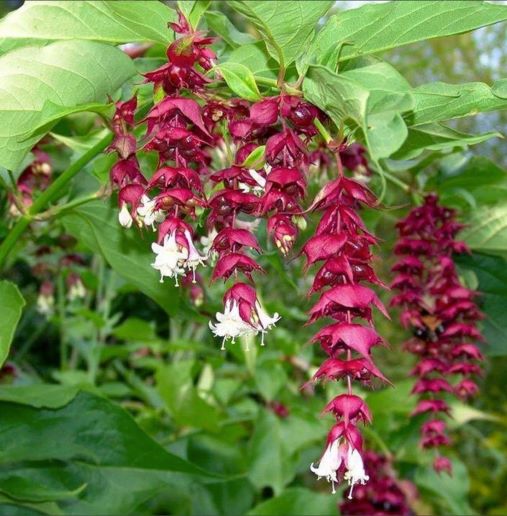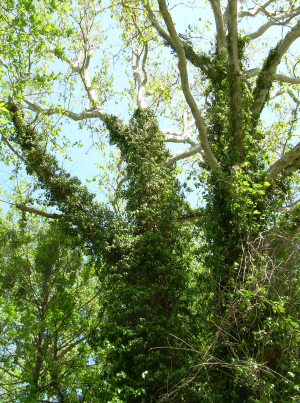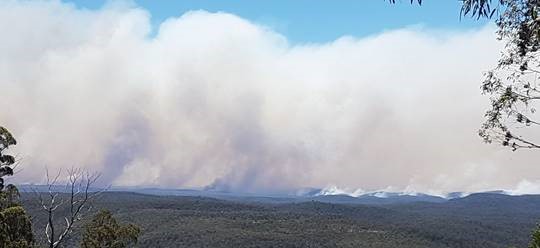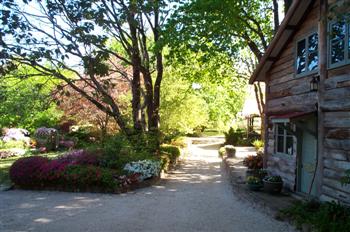Uncategorised
Himalayan Honeysuckle (Leycesteria formosa)
- Details
 Himalayan Honeysuckle invades sensitive moist bushland such as Blue Mountains swamps where it forms thickets and dense shade, displacing native vegetation.
Himalayan Honeysuckle invades sensitive moist bushland such as Blue Mountains swamps where it forms thickets and dense shade, displacing native vegetation.
A deciduous multi-stemmed shrub to 3 m high. Stems are erect, hollow and bamboo-like. A native of the Himalayas. Leycesteria is a vigorous arching shrub with large, soft green leaves and drooping panicles of white flowers which are followed by clusters of shining dark purple berries spread in December and January by the birds. These plants grow well in the semi-shade of the rainforest.
Fruits are ovoid fleshy berries, dark crimson when ripe. Each fruit contains more than 100 small seeds.
Control
- The plant should be fully and continuously suppressed and destroyed
- Dig out, or cut off and poison every stem.
- Spray large areas November to March.
English Ivy (Hedera helix)
- Details
Whilst English ivy (Hedera helix) provides some lovely features and screens in our gardens this is very aggressive when out of control.
The Dandenong Ranges in Victoria (see video) are similar to Mt Wilson/Mt Irvine with the basalt soil and ornamental gardens and have a similar problem to the mounts with Ivy growing up trees and sometimes enveloping the whole tree.
Ivy is rampant in the village and eradication is difficult. However, we can all do something to limit the spread of ivy. Ivy flowers and produces fruit when it climbs up a tree and the seeds are then carried into gardens and the bush by birds. English ivy will eventually choke and kill trees, even big ones, both natives and exotics. To stop it spreading we need to focus on ivy growing on trees.
Tree Fern Treatment
For tree ferns the task is more complex as the ivy roots grow into the trunk. To kill the ivy the stems must be scraped with a knife and the herbicide applied to the ivy stem wound, being careful to avoid the tree fern trunk. This is best done in the growing season October to end April.
Non Tree Fern Tree Treatment
For other trees the process is much easier. Just cut the Ivy at the base and the Ivy should die. It is best also clearing about 1 m from the base of the tree. (see video)
Herbicide
Glyphosate (Roundup) is a herbicide that is used for killing English Ivy. Please note special care must be taken when using Glyphosate. The MWPA accepts no responsibility for the use or application of any chemicals. Always check the labels and Safety Data Sheets for all chemicals and use only as directed.
 Please note that the Blue Mountains Basalt Forest in around Mt Wilson is a ‘Blue Mountains Sensitive Vegetation Community’ so extreme care needs to be taken when controlling weeds in bushland areas. The only weed control methods recommended in sensitive areas are ‘scrape and paint’, ‘cut and paint’ and ‘stem injection’. If in any doubt about how to control weeds on your property consider using an accredited weed control contractor.
Please note that the Blue Mountains Basalt Forest in around Mt Wilson is a ‘Blue Mountains Sensitive Vegetation Community’ so extreme care needs to be taken when controlling weeds in bushland areas. The only weed control methods recommended in sensitive areas are ‘scrape and paint’, ‘cut and paint’ and ‘stem injection’. If in any doubt about how to control weeds on your property consider using an accredited weed control contractor.
Other Usefull references:
Weedwise Weed of the Month - English Ivy
Weedwise - English Ivy - Best Practices
WikiHow - How to kill English Ivy
Current Bushfire Status
- Details
Update about the Gospers Mountain Fire to the north of us, posted Wednesday, 11 December.
Gospers Mountain Bushfire Update - Plan to begin backburning today.

The Gospers Mountain bushfire seen yesterday from Smiths Hill was about 6 kms from Mount Irvine
The Fire
While we have a good weather window MWMIRFS Brigade will commence back burning into the area below Mount Irvine today to take advantage of the better conditions for creating a safety burnt area around Mt Irvine. This will involve lighting the bush from the fire trails around Mount Irvine then Mount Wilson to remove the fuel between the villages and the Gospers Mountain fire thereby protecting property in the villages. The back burn is a lower intensity burn usually lit at night and going downhill so as to reduce the impact on the surrounding bush while removing the fuel and protecting the area from the bushfire coming into the villages on a bad day.
On Tuesday the fire was holding on Bungleboori Creek (see yesterday’s Update map), north of Mt Wilson / Mt Irvine, but quite active on the Newnes Plateau. The back burn started at Mountain Lagoon has progressed as far as Bilpin. After a very hot day yesterday we are entering a good weather window until about Friday.
Access to the Mounts
A road block at Mt Wilson Road and the Bells Line of Road will restrict access to all vehicles other than residents and emergency services. Expect this to be in place for a couple of weeks.
Letters of authority were distributed last night to all residents providing access to named people on the presentation of the letter and ID like a local rates’ notice or a driver’s licence. If you need an authority for anyone else (other than Mount Wilson or Mount Irvine residents) please email to This email address is being protected from spambots. You need JavaScript enabled to view it. stating: first name, family name and email address. A personalised authority letter will be sent to the nominated person.
The trigger point for fire plans
The start of backburning is the trigger point for people to carry out their fire plans. If you plan to leave, today is the time to relocate. Leave, stay or come to the Mounts this is also the time to contact your Street Coordinator and tell them what you will be doing. A fire warning message may be sent to all mobile phones in the area when fire reaches a preset zone around both villages . Do not be alarmed by this, just follow the prompts and check with your street coordinator if the situation or conditions may have changed.
Once backburning starts we will see an increase of smoke in the area. From today expect increased movement of trucks, activity around both community halls and fire stations and road closures in areas as the backburn progress from Mount Irvine to Mount Wilson and on along Mt Wilson Road to Bells Line of Road.
Please slow down on the local roads, if possible pull over and let tucks pass. Do not enter the fire trails or the burn area as there will be many hazards, machinery operating, steep trails, falling trees and hot ash beds.
Anyone who would like to assist with Catering or Station work please contact the Brigade Station Officer on 4756 2168.
Peter Raines
Senior Deputy Captain
Mt Wilson-Mt Irvine RF Brigade
Map of Fires in NSW with the current status of each fire, Fires Near Me.
The map can be zoomed to show fires in our area.
Donating to Mt Wilson - Mt Irvine Community Groups
- Details
Tax deductible donations can be easily made by clicking on the following links below:
The Mt Wilson - Mt Irvine Rural Fire Brigade

